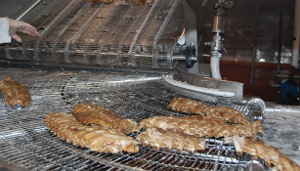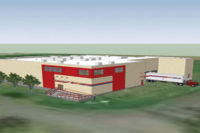
|
In the all-important effort to keep contaminants and pathogens far from the meat and poultry products in a processing plant, it is important that the conveyor systems not be overlooked. A good sanitation program is needed to ensure that the meat that is carried on the belt does not pick up any pathogens along the way. The first way to ensure good conveyor sanitation is to use a conveyor system that is specifically made for the food industry.
“You want to make sure that you’re buying conveyors from a company that has thought through and created them specifically for the food industry,” says Erika Voogd, president of Voogd Consulting, a firm that helps processors manage their food safety and quality programs, including animal welfare. She notes that processors who are using older systems or bought used conveyors may not have equipment specifically designed for food safety.
“The challenge is that conveyors have so many moving parts, it’s easy for the bacteria to find a home inside the moving parts,” she adds.
Gary McMurray, chief of the Georgia Tech Research Institute’s Food Processing Technology Division, adds that processors are increasingly aware of equipment design criteria established by the USDA and National Sanitation Foundation, and they are asking for equipment that is easier to clean.
The conveyors themselves can now be made with microbial-resistant coatings, and entire conveyor packages that can withstand washdown practices are more affordable.
“It used to be that companies would just get any old motor that would fit, and it was not necessarily a washdown motor,” he says. “You would see in a month or two that the motor was all rusted, and they would just say, ‘Eh, it’s under the conveyor, it doesn’t matter.’
“Now, people are more aware of these things,” McMurray continues. “Companies are starting to include the washdown motors that can survive in the environment and won’t rust.”
Even robots made to handle objects on the conveyors are becoming washdown-safe. That development, he says, should lead to increased automation on the food-contact side of the operation.
When it comes to cleaning and maintaining conveyors, Voogd says equipment suppliers can help a company determine the best practices and the best disassembly and cleaning schedule. The exact nature of the schedule can vary depending on the meat product on the conveyor and the type of conveyor. A metal conveyor, she says, can be soaked or cleaned out of place with very hot water or even heated in a smokehouse to kill any pathogens. Plastic conveyors can be routinely removed and soaked. Plastic conveyors require more attention to the cleaning chemicals and the temperature of the water so they don’t become brittle.
Voogd says that some processors clean the conveyor and swab it, and then they run the conveyor and swab it again.
“That tells if there are any harborage points,” she says. “If the equipment is sitting still after cleaning, you might not catch any bacteria it could be harboring, but once you run the conveyor, it disperses the bacteria that may be harboring inside of a hollow roller or the joints.”
Another strategy is to douse the cleaned conveyor with a sterile rinse, then catch the rinse and test it for bacteria.
“That way, you’re sampling whatever moisture runs through that conveyor belt and belting and determine whether there’s something hiding in the conveyor after you clean it,” she says. IP





Report Abusive Comment